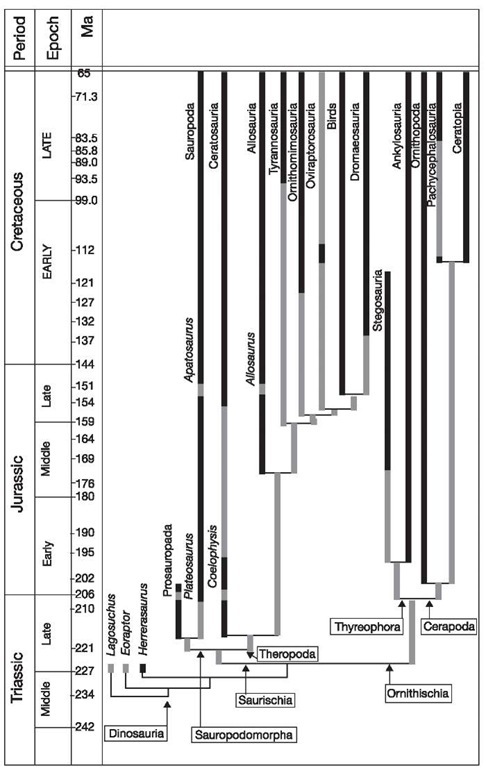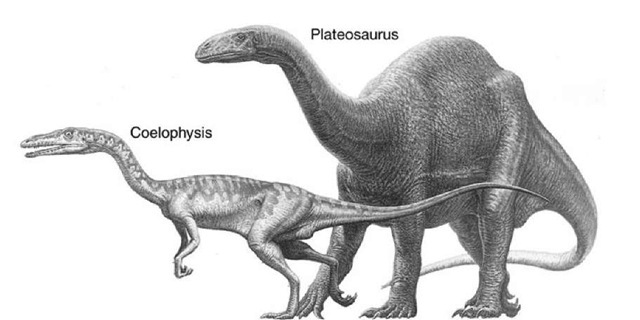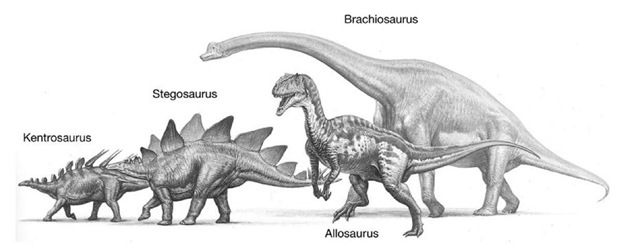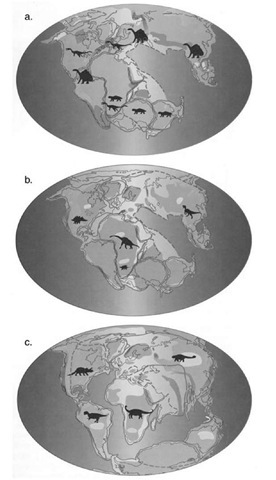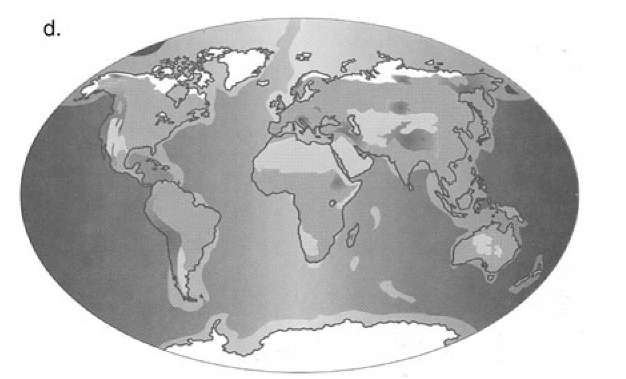Up to this point, our focus has been largely, if not exclusively, tuned to exploring aspects of the anatomy, biology, and way of life of the dinosaur Iguanodon. It must be obvious that Iguanodon was just one dinosaur that fitted into far larger tableaux of life in the Mesozoic Era. One of the important tasks that falls to palaeontologists is to try to discover the genealogy, or evolutionary history, of the species that they study. To put dinosaurs as a whole into some sort of perspective, it will be necessary to outline the techniques used to do this, and our current understanding of dinosaurian evolutionary history.
One feature of the fossil record is that it offers the tantalizing possibility of tracing the genealogy of organisms not just over a few human generations (which is the ambit of modern genealogists) but over thousands, or millions, of generations, across the immensity of geological time. The primary means by which such research is carried out at present is the technique known as phylogenetic systematics. The premise of this technique is really quite simple. It accepts that organisms are subject to the general processes of Darwinian evolution. This does not require anything more profound than the assumption that organisms that are more closely related, in a genealogical sense, tend to physically resemble each other more closely than they do more distantly related creatures. To try to investigate the degree of relatedness of creatures (in this particular case fossil creatures), palaeosystematists are most interested in identifying as wide a range of anatomical features as are preserved in the hard parts of their fossils. Unfortunately, a great deal of really important biological information has simply rotted and been lost during the process of fossilization of any skeleton, so, being pragmatic about things, we simply have to make the most of what is left. Until quite recently, the reconstruction of phylogenies had relied on hard-part anatomical features of animals alone; however, technological innovations have now made it possible to compile data, based on the biochemical and molecular structure of living organisms, that can add significant and new information to the process.
What the dinosaur systematist has to do is compile lengthy lists of anatomical characteristics, with the intention of identifying those that are phylogenetically important, or contain an evolutionary signal. The task is intended to produce a workable hierarchy of relationship, based on groupings of ever more closely related animals.
The analysis also identifies features that are unique to a particular fossil species; these are important because they establish the special characteristics that, for example, distinguish Iguanodon from all other dinosaurs. This probably sounds blindingly obvious but, in truth, fossil creatures are often based on a small number of bones or teeth. If other partial remains are discovered in rocks elsewhere from the original, but of very similar age, it can be quite a challenge to prove convincingly whether the new remains belong to, say, Iguanodon, or perhaps a new and previously undiscovered creature.
Beyond the features that identify Iguanodon as unique, there is also a need to identify anatomical features that it shares with other equally distinct, but quite closely related animals. You might say that these were the equivalent of its anatomical ‘family’. The more general the characters that ‘family’ groups of dinosaurs share, the more this allows them to be grouped into ever larger and more inclusive categories of dinosaurs that gradually piece together an overall pattern of relationships for them all.
The case of Baryonyx
The Early Cretaceous rocks of south-east England have been intensely investigated by fossil hunters (starting with Gideon Mantell) and geologists (notably William Smith) for well over 200 years. Iguanodon bones are very common, as are the remains of a limited range of other dinosaurs, such as ‘Megalosaurus’, Hylaeosaurus, Polacanthus, Pelorosaurus, Valdosaurus, and Hypsilophodon. Given the intensity of such work, it would be thought highly unlikely that anything new would ever be discovered. However, in 1983 the amateur collector William Walker discovered a large claw bone in a clay pit in Surrey that led to the excavation of an 8-metre-long predatory dinosaur that was entirely new to science. It was named Baryonyx walkeri in honour of its discoverer, and has pride of place on exhibition at the Natural History Museum in London.
The moral of this story is that nothing should be taken for granted; the fossil record is likely to be full of surprises.
The real question is: how is this overall pattern of relationships achieved? For a very long time, the general method that was used might be described simply as ‘I know best’. It was quite literally the view of self-styled experts, who had spent much time studying a particular group of organisms and then summarized the overall patterns of similarity for their group; their methods for doing this might vary considerably, but in the end their preferred pattern of relationship was little more than just that: their preference, rather than a rigorous, scientifically debated solution. While this method worked reasonably well for restricted groups of organisms, it proved far more difficult to properly debate the validity of one interpretation compared with another because the arguments, when boiled down to their essentials, were circular, relying on one person’s belief over another’s.
This underlying problem was brought into sharp focus when groups of organisms were very large in number and varied in many subtle ways. Good examples are groups of insects, or some of the bewildering varieties of bony fish. If the general scientific community was happy to accept the authority of one scientist for a period of time then all was apparently fine. However, if experts could not agree, the end result was frustratingly circular debates.
Over the past four decades, a new methodology has gradually been adopted that has proved far more valuable scientifically. It does not necessarily give the correct answers, but it is at least open to scientific scrutiny and real debate. This technique is now widely known as cladistics (phylogenetic systematics). The name is treated with a fair degree of trepidation by some, but this is largely because there have been some very fierce arguments about how cladistics is done in practice and what the overall significance of the results might be in an evolutionary context. Fortunately, we do not need to consider much of this debate because the principles are actually surprisingly simple and clear-cut.
A cladogram is a branching tree diagram that links together all the species that are being investigated at the time. To create one, the researcher needs to compile a table (data matrix) containing a column listing the species under consideration and against this a compilation of the features (anatomical, biochemical, etc.) that each species exhibits. Each species is then ‘scored’ in relation to whether it does (1) or does not (0) possess each character, or in some instances if the decision is uncertain this can be signified as a (?). The resulting matrix of data (these can be very large) is then analysed using a number of proprietary computer programs, whose role is to assess the distribution of 1s and 0s and generate a set of statistics that determines the most parsimonious distribution of the data that are shared by the various species. The resulting cladogram forms the starting point for a considerable amount of further investigation that is aimed at determining and understanding the degree to which there are common patterns or overall similarities, and the extent to which the data might be misleading or erroneous.
The cladogram that results from this type of analysis represents no more than a working hypothesis of the relationships of the animals that are being investigated. Each of the branches on the tree mark points at which it is possible to define a group of species that are all connected by their sharing a number of characteristic features. And using this information it is possible to construct what is, in effect, a sort of genealogy or phylogeny representing a model of the evolutionary history of the group as a whole. For example, if the known geological times of occurrence of each of the species are plotted on to this pattern, it becomes possible to indicate the overall history of the group, and also the probable time at which various of the species may have originated. In this way, the cladogram, rather than simply representing a convenient spatial arrangement of species, begins to resemble a real genealogy. Obviously, each such phylogeny created in this way is only as good as the data available, and the data and how it is scored can change with the discovery of new, better, or more complete fossils, and also as new methods of analysis are developed or older ones are improved upon.
The aim of all this work is to help create as accurate a picture as possible of the evolutionary history of life or, in this particular case, the evolutionary history of dinosaurs.
28. Dinosaur cladogram
An evolutionary history of the dinosaurs: in brief
An interesting example of this type of systematic approach to the evolution of dinosaurs is represented by the work of Paul Sereno of the University of Chicago. Sereno has spent considerable time, over the past two decades, investigating the systematics and general evolutionary history of dinosaurs. Figure 28 summarizes this work and permits an all too brief overview.
Dinosauria are traditionally recognized (as Owen so perceptively saw) as reptiles with an upright leg posture and specially reinforced connections between the hips and vertebral column to facilitate the efficient carriage of the body on its pillar-like legs. These changes conferred upon early dinosaurs some highly valuable assets: pillar-like legs could support great body weight very effectively and dinosaurs could become very large creatures; and, pillar-like legs allow a long stride, meaning that some dinosaurs could move very quickly. Both attributes were used very effectively by dinosaurs throughout their reign on Earth.
While all dinosaurs share these crucial features, they can be divided into two fundamentally different types: the Saurischia (literally, ‘lizard-hipped’) and Ornithischia ("bird-hipped’). As these names suggest, the differences between such dinosaurs lie primarily in the structure of their hip bones, although several other more subtle anatomical features are important in helping to distinguish these two major types. The earliest members of both groups of dinosaur have been identified in rocks of Carnian age (at least 225 Ma), but it has not been possible to identify the earliest dinosaur of all or whether it was strictly a saurischian, ornithischian, or just a dinosaurian that was not yet either.
Saurischian dinosaurs
Saurischians include two major groups. Sauropodomorpha are mainly large-bodied creatures with pillar-like legs, extraordinarily long tails, long necks ending in small heads, and jaws lined with simple, peg-shaped teeth, indicating a mainly herbivorous diet. These include such giants as members of the diplodocoid, brachiosauroid (Figure 31), and titanosaurian groups. Theropoda are markedly different to their sauropodomorph relatives. They are almost entirely agile, bipedal, and predominantly meat-eating dinosaurs (Figures 30, 31). A long, muscular tail counterbalances the front of the body at the hip, leaving the arms and hands free to be used to grab their prey; their heads also tend to be rather large, and their jaws lined with sharp, knife-like teeth. These types of dinosaur range from small and rather delicate creatures similar to Compsognathus, which are commonly referred to as coelurosaurs, through to such enormous creatures such as the legendary Tyrannosaurus, while other equally large and fearsome-looking theropods include Giganotosaurus, Allosaurus, Baryonyx, and Spinosaurus. Although some of these dinosaurs may be well known, the group as a whole is proving to be extraordinarily diverse, and in some cases quite bizarre. Newly discovered therizinosaurs, for example, appear to have been huge, lumbering creatures with long, scythe-like claws on their hands, enormous bellies, and ridiculously small heads whose jaws were lined with teeth that are far more reminiscent of plant-eaters than conventional meat-eaters. Yet other theropods known as ornithomimians and oviraptorians were lightly built, rather ostrich-like creatures that were entirely toothless (and therefore beaked just like living birds). However, the source of greatest interest among this entire group of dinosaurs is the subgroup known as dromaeosaurians.
Dromaeosaurians include such renowned creatures as Velociraptor and Deinonychus, and a host of similar but less famous creatures that have been discovered recently. Their particular interest lies in the fact that their skeletal anatomy is closely similar to that of living birds; indeed, the similarities are so great that they are thought to be direct bird ancestors. Dramatic new discoveries, at sites in Liaoning Province, China, that exhibit truly exceptional preservational conditions, of dromaeosaurian theropods reveal a body covering made of either keratinous filaments (like a coarse form of hair) or in some cases genuinely bird-like feathers, which emphasizes their similarity to modern birds.
29. Deinonychus. A reconstruction from bone to flesh. Perhaps it too had a filamentous covering?
Ornithischian dinosaurs
All ornithischians are thought to have been herbivorous and, rather like modern-day mammals, they seem to be far more diverse, and numerous, than their potential predators.
Thyreophorans (Figure 28) are a major group of ornithischians that are characterized by bearing bony plates in their body wall, clubs or spikes adorning their tails, and for having an almost exclusively quadrupedal method of locomotion. These types of dinosaur include the stegosaurs, named after the iconic Stegosaurus (well known for its tiny head, the rows of large bony plates on its back, and its spiky tail (Figure 31)); and the heavily armoured ankylosaurs including such creatures as Euoplocephalus. The latter was a huge tank-like animal that was so heavily armour-plated that even its eyelids were reinforced by bony shutters and its tail was terminated in a huge, bony club that it presumably used to skittle potential predators.
30. Triassic saurischian dinosaurs. The early theropod Coelophysis, and sauropodomorph Plateosaurus.
31. Jurassic ornithischian thyreophoraus: Kentrosaurus and Stegosaurus. The saurischian theropod Allosaurus and the sauropodomorph Brachiosaurus.
Cerapodans (Figure 28) were very different to thyreophorans. These were typically lightly built, unarmoured bipeds, although a few did revert to quadrupedal methods of locomotion. Ornithopods were one major group of cerapodans. Many of these dinosaurs were medium-sized (2-5 metres long) and quite abundant (probably filling the ecological niches occupied by antelopes, deer, sheep, and goats today). These animals, such as Hypsilophodon, were balanced at the hip (just like theropods), had slender legs for fast running, grasping hands, and, most importantly, teeth, jaws, and cheeks adapted for a diet of plants. Throughout the reign of the dinosaurs, small to medium-sized ornithopods were quite abundant, but through the Mesozoic a significant number of larger types evolved; these are known as iguanodontians (because they include animals such as Iguanodon). Most important of all the iguanodontians were the extraordinarily numerous duck-billed, or hadrosaurian, dinosaurs of the Late Cretaceous of North America and Asia. Some (but not all) of these dinosaurs did indeed have rather duck-shaped snouts, and others had a wide range of quite extravagant, hollow-crested headgear (see topic 7); this headgear may well have been used for social signalling, and more particularly for making loud, honking sounds. Marginocephalians were the other major cerapodan group and appeared in Cretaceous times. These included the extraordinary pachycephalosaurs (‘thick-headed dinosaurs’); they had bodies that were very similar in general appearance to the ornithopods, but their heads were very odd-looking. The majority had a high dome of bone on the top, which looked vaguely similar to the headgear of hadrosaurians, except for the fact that pachycephalosaur headgear was made of solid bone. It has been suggested that these creatures were the ‘headbangers’ of the Cretaceous world – perhaps using head clashing in similar fashion to that seen among some cloven-hooved animals today.
Finally, there were the ceratopians, a group of dinosaurs that included the fabled Protoceratops referred to in the Introduction, as well as the well-known Triceratops (‘three-horned face’). All had a singular narrow beak at the tip of the jaws and tended to have a ruff-like collar of bone at the back edge of the skull. While some of these dinosaurs, particularly the early ones, maintained a bipedal way of life, a considerable number grew greatly in body size, with an enlarged head, which was adorned with a huge frill-like collar and large eyebrow and nose horns. Their great bulk and heavy head led them to adopt a four-footed stance, and their similarity to modern-day rhinoceros has not gone unnoticed. Clearly, as this all too brief survey shows, dinosaurs were many and varied, judging by the discoveries made over the past 200 years. But even though to date about 900 genera of dinosaurs are known, this is only a tiny fraction of the dinosaurs that lived during the 160 million years of their reign during the Mesozoic Era. Many of these will, unfortunately, never be known: their fossils were never preserved. Others will be discovered by intrepid dinosaur hunters in years to come.
Dinosaur systematics and ancient biogeography
This type of research can have interesting, if slightly unexpected, spin-offs. One spin-off that will be considered here links phylogenetics with the geographic history of the Earth. The Earth may in fact have exerted a profound influence on the overall pattern of life.
The geological timescale of the Earth was pieced together through painstaking analysis of the relative ages of sequences of rocks exposed at various places on Earth. One important component that assisted this process was the evidence of the fossils that they contained: if rocks from different places contained fossils of exactly the same type, then it could be assumed with reasonable confidence that the rocks were of the same relative age.
In broadly similar fashion, evidence of the similarity of fossils from different parts of the world began to suggest that the continents might not have been as fixed in their positions as they appear to be today. For example, it had been noted that rocks and the fossils that they contained seemed to be remarkably similar on either side of the southern Atlantic Ocean. A small aquatic reptile Mesosaurus was known to exist in remarkably similar-looking Permian rocks in Brazil and in South Africa. As long ago as 1620, Francis Bacon had pointed out that the coastlines of the Americas and Europe and Africa seemed remarkably similar, (see Figure 32d) to the extent that it seemed as if they could have fitted together as a pair of gigantic jigsaw pieces. On the basis of evidence from fossils, rocks, and general shape correspondence, Alfred Wegener, a German meteorologist, suggested in 1912 that at times in the past the continents of the Earth must have occupied different positions to the ones they are in today, with, for example, the Americas and Eur-Africa nestled together in the Permian Period. Because he was not a trained geologist, Wegener’s views were ignored, or dismissed as irrelevant and unprovable speculations. For all its self-evident persuasiveness, Wegener’s theory lacked a mechanism: common sense dictated that it was impossible to move things the size of continents across the solid surface of the Earth.
However, common sense proved to be deceptive. In the 1950s and 1960s, a series of observations accumulated that supported Wegener’s views. Firstly, very detailed models of all the major continents showed that they did indeed fit together remarkably neatly and with a correspondence that could not be accounted for by chance. Secondly, major geological features on separate continents became continuous when continents were reassembled jigsaw-like. And finally, palaeomagnetic evidence demonstrated the phenomenon of sea-floor spreading – that the ocean floors were moving like huge conveyor belts carrying the continents – and the historical remnants of magnetism in continental rocks confirmed that the continents had moved over time. The ‘motor’ that was driving this motion was in effect the heat at the core and the fluidity of rocks in the mantle layer inside the Earth. The theory of plate tectonics that accounts for the movement of continents over the surface of the Earth over time is now well established and corroborated.
From a dinosaur evolutionary perspective, the implications of plate tectonics are extremely interesting. Reconstructions of past configurations of the continents, largely based on palaeomagnetics and detailed stratigraphy, indicate that at the time of their origin all the continents were lying clustered together in a single gigantic landmass, known as Pangaea (‘all Earth’) (Figure 32a). Dinosaurs at this time were quite literally capable of walking all over the Earth, and in reflection of this it appears to be the case that the fossil remains of rather similar types (theropods and prosauropods) have been found on nearly all continents.
During subsequent Periods, the Jurassic (Figure 32b) and Cretaceous (Figure 32c), it is evident that the supercontinent began to fragment as the immensely powerful tectonic conveyor belts imperceptibly, but remorselessly, wrenched Pangaea apart. The end product of this process at the close of the Cretaceous was a world that, though still different geographically (note particularly the position of India in Figure 32c), has some very familiar-looking continents.
The earliest dinosaurs seem to have been able to disperse across much of Pangaea, judging by their fossils. However, during the Jurassic and subsequent Cretaceous Periods it was clearly the case that the unified supercontinent became gradually subdivided by intervening seaways as continent-sized fragments gradually drifted apart.
32. The changing continents. a. Triassic Period showing the single supercontinent called Pangaea. b. Middle Jurassic Period. c. Early Cretaceous Period. Note that the dinosaur images become increasingly different as the continents separate from one another.
32(d). The continents as they are today. Close the Atlantic Ocean and the Americas fit neatly against West Africa.
An inevitable biological consequence of this intrinsic (Earth-bound) process of continental sundering is that the once cosmopolitan population of dinosaurs became progressively subdivided and isolated. The phenomenon of isolation is one of the keystones of organismal evolution – once isolated, populations of organisms tend to undergo evolutionary change in response to local changes to their immediate environment. In this instance, although we are dealing with comparatively huge (continent-sized) areas, each of the continental fragments carried its own population of dinosaurs (and associated fauna and flora); each of which, with the passing time, had the opportunity to evolve independently in response to local changes in environment, stimulated by, for example, progressive changes in latitude, longitude, adjacent oceanic currents, and prevailing atmospheric conditions.
Logic dictates that it must clearly have been the case that tectonic events during the Mesozoic affected the scope and overall pattern of the evolutionary history of dinosaurs. Indeed, it seems perfectly reasonable to suppose that the progressive fragmentation of ancestral populations over time must have done much to accelerate the diversification of the group as a whole. Just as we can represent the phylogeny of dinosaurs using cladograms, we could also represent the geographic history of the Earth through the Mesozoic Era as a series of branching events as continental areas separated from the ‘ancestral’ Pangaean Earth. Of course, this general approach is a simplification of true Earth history because, on occasion, continental fragments have coalesced, welding together previously isolated populations. But at least as a first approximation, this provides a fertile area for investigating some of the larger-scale events in Earth history.
If this model of the natural history of dinosaurs were generally true, we might expect to be able to detect some evidence in its support by probing the details of the fossil record of dinosaur species, and the tectonic models of continental distribution through the Mesozoic. This type of approach has been developed in recent years to probe for coincident patterns in the evolutionary history of dinosaurs and whether their evolutionary history is echoed in their geographic distribution.
Ornithopod evolution
The earliest work in this field of research, carried out in 1984, concerned a group of dinosaurs that are quite closely related to the familiar Iguanodon. Generally, these types of dinosaur are known as ornithopods (bird feet’ – this comes from a passing, trivial resemblance in the structure of the feet of these dinosaurs to those of modern birds). Comparing in some detail the anatomy of a number of the then known ornithopods, a cladogram was constructed. To convert this into a genuine phylogeny it was necessary to chart on to the cladogam the known distribution of this group through time and their geographic distributions.
Some surprising patterns in the history of these ornithopod dinosaurs emerged from this analysis. First it seemed to demonstrate that the forms most closely related to Iguanodon (that is to say, members of the group known as iguanodonts) and their closest relatives (members of the hadrosaur family) probably originated as a result of continental separation during Late Jurassic times. The ancestral population from which both groups may have evolved became subdivided by a seaway at this time. Following this isolation, one population evolved into the hadrosaurs in Asia, while iguanodonts evolved elsewhere. These two groups appear to have evolved distinct from one another through the Late Jurassic and Early Cretaceous period. However, during the latter half of the Cretaceous, Asia became reconnected to the rest of the northern hemisphere continents and its hadrosaurs were apparently able to spread across the northern hemisphere pretty much unhindered and replaced iguanodonts wherever they came into contact.
While the pattern of replacement of iguanodonts by hadrosaurs in Late Cretaceous times appeared to be reasonably uniform, there were one or two puzzling anomalies that needed to be investigated.
There were reports, written at the turn of the 20th century, of iguanodonts from Europe (primarily France and Romania) in rocks of very latest Cretaceous age. From the analysis above, these would not have been expected to have survived into Late Cretaceous times because everywhere else the pattern was one of hadrosaurs replacing iguanodonts. In the early 1990s, the best-preserved material came from Transylvania, a region of Romania. However, the phylogenetic analysis prompted expeditions to reinvestigate these discoveries. Fresh study proved that this dinosaur was not a close relative of Iguanodon, but represented an unusually long-lasting (relict) member of a more primitive group of ornithopods. An entirely new name was created for this dinosaur: Zalmoxes. So, one of the outcomes of the preliminary analysis was a great deal of new information about an old, but apparently not so well understood, dinosaur.
A report published in the 1950s suggested that a very Iguanodon-like dinosaur lived in Mongolia in Early Cretaceous times. This tantalizing report also needed to be investigated further to check whether its anomalous geographic range – in Asia in Early Cretaceous times – was real or, as in the Romanian example, another case of mistaken identity. The material, though fragmentary, was stored in the Russian Palaeontological Museum in Moscow, and had to be re-examined. What emerged was again not as expected. This time the earlier reports proved correct, the genus Iguanodon itself seemed to be present in Mongolia in Early Cretaceous times, and the pieces recovered were indistinguishable from the very well known European Iguanodon.
This second discovery did not fit at all comfortably with the evolutionary and geographic hypothesis that had been created in the 1984 analysis. Indeed, in more recent years a suite of very interesting Iguanodon-like ornithopods have emerged in Asia, as well as North America, in what can best be described as ‘middle’ Cretaceous times. Much of this very recent, and steadily accumulating, evidence suggests that the original evolutionary and geographic model had a number of fundamental flaws that continued investigation and new discoveries were able to expose.
Dinosaurs: a global perspective
In more recent times, this approach has been applied much more broadly and in a much more ambitious way. Paul Upchurch of University College London and Craig Hunn at Cambridge hoped to explore the entire family tree of the Dinosauria for evidence of similarities in patterns of stratigraphic ranges and cladistic patterns by looking at large numbers of dinosaurs. These were compared to the currently established distributions of the continents at intervals through the entire Mesozoic Era. An attempt was being made to find out whether an overall signal did emerge that was suggestive of a tectonic influence on the evolutionary history of all dinosaurs.
Despite the inevitable ‘noise’ in the system resulting largely from the incompleteness of the fossil record of dinosaurs, it was heartening to note that statistically significant coincident patterns emerged within the Middle Jurassic, the Late Jurassic, and the Early Cretaceous intervals. This indicates that tectonic events do, as expected, play some role in determining where and when particular groups of dinosaurs flourished. What is more, this effect has also been preserved in the stratigraphic and geographic distributions of other fossil organisms, so the evolutionary history of great swathes of organisms was effected by tectonic events and the imprint is still with us today. In a way, this is not new. I need only point to the unusual distribution of marsupial mammals (found only in the Americas and Australasia today), and the fact that distinct areas of the modern world have their own characteristic fauna and flora. What this new research suggests is that we may well be able to trace the historical reasons for these distributions far more accurately than we had supposed possible.
